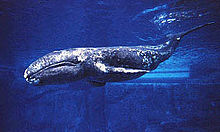Eschrichtiidae
| Eschrichtiidae Temporal range: Miocene–Recent |
|
|---|---|
 |
|
| Scientific classification | |
| Kingdom: | Animalia |
| Phylum: | Chordata |
| Class: | Mammalia |
| Order: | Artiodactyla |
| Infraorder: | Cetacea |
| Parvorder: | Mysticeti |
| Family: |
Eschrichtiidae Ellerman & Morrison-Scott 1951 |
| Genera | |
| Synonyms | |
|
|
Eschrichtiidae or the gray whales is a family of baleen whale (suborder Mysticeti) with a single extant species, the gray whale (Eschrichtius robustus). The family, however, also includes three described fossil genera: Archaeschrichtius and Eschrichtioides from the Miocene and Pliocene of Italy respectively, and Gricetoides from the Pliocene of North Carolina. The names of the extant genus and the family honours Danish zoologist Daniel Eschricht.
A number of 18th century authors described the gray whale as Balaena gibbosa, the "whale with six bosses", apparently based on a brief note by Dudley 1725:
The Scrag Whale is near a kin to the Fin-back, but instead of a Fin upon his Back, the Ridge of the Afterpart of his Back is cragged with half a Dozen Knobs or Nuckles; he is nearest the right Whale in Figure and for Quantity of Oil; his Bone is white, but won't split.
The gray whale was first described as a distinct species by Lilljeborg 1861 based on a subfossil found in the brackish Baltic Sea, apparently a specimen from the now extinct north Atlantic population. Lilljeborg, however, identified it as "Balaenoptera robusta", a species of rorqual.Gray 1864 realized that the rib and scapula of the specimen was different from those of any known rorquals, and therefore erected a new genus for it, Eschrichtius.Van Beneden & Gervais 1868 were convinced that the bones described by Lilljeborg could not belong to a living species but that they were similar to fossils that Van Beneden had described from the harbour of Antwerp (most of his named species are now considered nomina dubia) and therefore named the gray whale Plesiocetus robustus, reducing Lilljeborg's and Gray's names to synonyms.
Scammon 1869 produced one of the earliest descriptions of living Pacific gray whales, and notwithstanding that he was among the whalers who nearly drove them to extinction in the lagoons of the Baja California Peninsula, they were and still are associated with him and his description of the species. At this time, however, the extinct Atlantic population was considered a separate species (Eschrischtius robustus) from the living Pacific population (Rhachianectes glaucus).
...
Wikipedia
